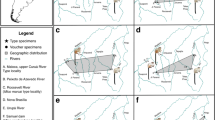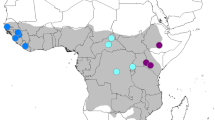Abstract
The criteria for the application of subspecific units in living primate populations have received little attention relative to other vertebrate taxa, even though they have important implications for conservation strategies for many nonhuman primate populations. One of the most critically endangered primates is the mountain gorilla,Gorilla gorilla beringei, of which 600 animals exist in east-central Africa. FollowingSarmiento et al. (1996), taxonomists have proposed splitting these populations into two subspecies as part of a revised taxonomy of the genusGorilla. In this paper I review the application of the subspecies concept in primatology, using the gorillas of Bwindi Impenetrable National Park and the Virungas as case studies. An examination of genetic, morphological, biogeographic, ecological, and behavioral evidence indicates that reclassifying Bwindi gorillas as taxonomically distinct from those in the Virungas is not well supported and needs further study. Because taxonomy provides the basis of conservation management policies, a cautious and conservative approach to the subspecies question is warranted in the case of endangered primate populations.
Similar content being viewed by others
References
Achoka, I. 1994. Home range, group size and group composition of mountain gorillas (G. g. beringei) in the Bwindi-Impenetrable National Park, southwestern Uganda. M.Sc. thesis, Makerere Univ., Kampala, Uganda.
Albrecht, G. H.;Miller, J. M. A. 1993. Geographic variation in primates: a review with implications for interpreting fossils. In:Species, Species Concepts, and Primate Evolution,Kimbel,W. H.;Martin,L. B. (eds.), Plenum Press, New York, pp. 123–162.
Casimir, M. J. 1975. Feeding ecology and nutrition of an eastern gorilla group in the Mt. Kahuzi region.Folia Primatol., 24: 81–136.
Coolidge, H. J., Jr. 1929. A revision of the genusGorilla.Memoirs of the Museum of Comp. Zool., Harvard, 50: 293–381.
Courtenay, J.;Groves, C.;Andrews, P. 1988. Inter-or intra-island variation?: an assessment of the differences between Bornean and Sumatran Orang-utans. In:Orang-utan Biology,Schwartz,J. H. (ed.), Oxford Univ. Press, Oxford, pp. 19–29.
Cracraft, J. 1983. Species concepts and speciation analysis.Cur. Ornithology, 1: 159–187.
Cracraft, J. 1989. Speciation and its ontology: the empirical consequences of alternative species concepts for understanding patterns and processes of differentiation. In:Speciation and its Consequences,Otte,D.;Endler,J. A. (eds.), Sinauer Associates, Sunderland, Massachusetts, pp. 28–59.
Dobzhansky, T. 1937.Genetics and the Origin of Species. Columbia Univ. Press, New York.
Doran, D. M.;McNeilage, A. 1998. Gorilla ecology and behavior.Evol. Anthropol., 6: 120–131.
Fossey, D. 1983.Gorillas in the Mist. Houghton Mifflin, Boston.
Fossey, D.;Harcourt, A. H. 1977. Feeding ecology of free-ranging mountain gorillas (Gorilla gorilla beringei). In:Primate Ecology,Clutton-Brock,T. H. (ed.), Academic Press, London, pp. 415–447.
Froelich, J. W. 1996. Primate species: the irreversible units in the evolution of our mammalian divergence.Amer. J. Primatol., 38: 271–279.
Froelich, J. W.;Supriatna, J.;Froelich, P. H. 1991. Morphometric analyses of Ateles: systematic and biogeographic implications.Amer. J. Primatol., 25: 1–22.
Gagneux, P.; Wills, C.; Gerloff, U.; Tautz, D.; Morin, P. A.; Boesch, C.; Fruth, B.; Hohmann, G.; Ryder, O. A.; Woodruff, D. S. 1996. Mitochondrial sequences show diverse evolutionary histories of African hominoids. In:Proceedings of National Academy of Sciences, pp. 5077–5082.
Garner, K. J.;Ryder, O. A. 1996. Mitochondrial DNA diversity in gorillas.Molecular Phylogen. Evol., 6: 39–48.
Godfrey, L.;Marks, J. 1991. The nature and origins of primate species.Yrbk. Phys. Anthropol., 34: 39–68.
Goldberg, T.;Ruvolo, M. 1997. Molecular phylogenetics and historical biogeography of East African chimpanzees.Biol. J. Linnean Society, 61: 301–323.
Goldsmith, M. L.;Stanford, C. B. 1997. The Bwindi-Impenetrable Great Ape Project, Uganda.Gorilla Conserv. News, 11: 17–18.
Groves, C. P. 1970. Population systematics of the gorilla.J. Zool., 161: 287–300.
Groves, C. P. 1986. Systematics of the great apes. In:Comparative Primate Biology, I: Systematics, Evolution, and Anatomy,Swindler,D. R.;Erwin,J. (eds.), Alan R. Liss, New York, pp. 187–217.
Groves, C. P.;Stott, K. W. 1979. Systematic relationships of gorillas from Kahuzi, Tshiaberimu and Kayonza.Folia Primatol., 32: 161–179.
Hamilton, A. C. 1974. Distribution patterns of forest trees in Uganda and their historical significance.Vegetation, 29: 21–35.
Hamilton, A. C.;Taylor, D.;Vogel, J. C. 1986. Early forest clearance and environmental degradation in south-west Uganda.Nature, 320: 164–167.
Harcourt, A. H. 1996. Is the gorilla a threatened species?: How should we judge?Biol. Conserv., 75: 165–176.
International Union for the Conservation of Nature. 1996.Red List. Glan, Switzerland.
Johnson, N. K. 1982. Retain subspecies: at least for the time being.The Auk, 99: 605–606.
Jolly, C. J. 1993. Species, subspecies, and baboon systematics. In:Species, Species Concepts, and Primate Evolution,Kimbel,W. H.;Martin,L. B. (eds.), Plenum Press, New York, pp. 67–108.
Keith, S. 1980. The avifauna of the Impenetrable Forest, Kigezi, Uganda, with special reference to altitudinal distribution. In:Proceedings IV Pan-African Ornithological Congress, pp. 159–167.
Kimbel, W. H.;Martin, L. B. (eds.). 1993.Species, Species Concepts, and Primate Evolution. Plenum Press, New York.
Kingdon, J. 1989.Island Africa. Princeton Univ. Press, Princeton.
Kuroda, S.;Nishihara, T.;Suzuki, S.;Oko, R. 1996. Sympatric chimpanzees and gorillas in the Ndoki Forest, Congo. In:Great Ape Societies,McGrew,W. C.;Marchant,L. F.;Nishida,T. (eds.), Cambridge Univ. Press, Cambridge, pp. 71–81.
Larson, A. 1989. The relationship between speciation and morphological evolution. In:Speciation and its Consequences,Otte,D.;Endler,J. A. (eds.), Sinauer Associates, Sunderland, Massachusetts, pp. 579–598.
Mayr, E. 1942.Systematics and the Origin of Species. Columbia Univ. Press, New York.
Mayr, E. 1982a.The Growth of Biological Thought. Harvard Univ. Press, Cambridge, Massachusetts.
Mayr, E. 1982b. Of what use are subspecies?The Auk, 99: 593–595.
Nishihara, T. 1995. Feeding ecology of western lowland gorillas in the Nouabalé-Ndoki National Park, Congo.Primates, 36: 151–168.
Paterson, H. E. H. 1985. The recognition concept of species. In:Species and Speciation: Transvaal Museum Monograph 4,Vrba,E. S. (ed.), Transvaal Museum, Pretoria, pp. 21–29.
de Quieroz, K.;Gauthier, J. 1994. Toward a phylogenetic system of biological nomenclature.Trends in Ecol. Evol., 9: 27–31.
de Quieroz, K.;Good, D. A. 1997. Phenetic clustering in biology: a critique.Quart. Rev. Biol., 72: 3–30.
Remis, M. J. 1997. Western lowland gorillas (Gorilla gorilla gorilla) as seasonal frugivores: use of variable resources.Amer. J. Primatol., 43: 87–109.
Rosen, D. E. 1978. Vicariant patterns and historical explanations in biogeography.Systematic Zool., 27: 159–188.
Sarmiento, E.;Butynski, T.;Kalina, J. 1996. Ecological, morphological, and behavioral aspects of gorillas of Bwindi-Impenetrable and Virungas National Parks, with implications for gorilla taxonomic affinities.Amer. J. Primatol., 40: 1–21.
Schaller, G. B. 1963.The Mountain Gorilla. Univ. of Chicago Press, Chicago.
Schultz, A. H. 1934. Some distinguishing features of the mountain gorilla.J. Mammal., 15: 51–61.
Shea, B. T.;Leigh, S. R.;Groves, C. P. 1993. Multivariate variation chimpanzees: implications for species identification in paleoanthropology. In:Speciation and its Consequences,Otte,D.;Endler,J. A. (eds.), Sinauer Associates, Sunderland, Massachusetts, pp. 265–296.
Simpson, G. G. 1961.Principles of Animal Taxonomy. Columbia Univ. Press, New York.
Sokal, R. R. 1973. The species problem reconsidered.Systematic Zool., 22: 360–374.
Storer, R. W. 1982. Subspecies and the study of geographic variation.The Auk, 99: 599–601.
Templeton, A. R. 1989. The meaning of species and speciation: a genetic perspective. In:Speciation and its Consequences,Otte,D.;Endler,J. A. (eds.), Sinauer Associate, Sunderland, Massachusetts, pp. 3–27.
Tutin, C. E. G.;Fernandez, M. 1993. Composition of the diet of chimpanzees and comparisons with that of sympatric lowland gorillas in the Lopé Reserve, Gabon.Amer. J. Primatol., 30: 195–211.
Watts, D. P. 1984. Composition and variability of mountain gorilla diets in the central Virungas.Amer. J. Primatol., 7: 323–356.
Yamagiwa, J.;Mwanza, N.;Yumoto, T.;Maruhashi, T. 1994. Seasonal change in the composition of the diet of eastern lowland gorillas.Primates, 35: 1–14.
Author information
Authors and Affiliations
About this article
Cite this article
Stanford, C.B. The subspecies concept in primatology: The case of mountain gorillas. Primates 42, 309–318 (2001). https://doi.org/10.1007/BF02629622
Received:
Accepted:
Issue Date:
DOI: https://doi.org/10.1007/BF02629622




